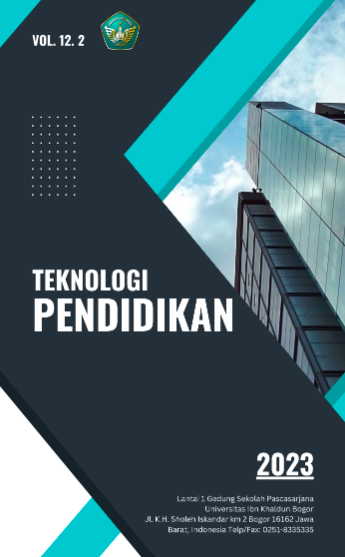PENGARUH PERSEPSI VOKASI TERHADAP PEMBELAJARAN BERBASIS TEACHING INDUSTRY: STUDI KASUS PADA MAHASISWA SARJANA TERAPAN BISNIS LOGISTIK UNIVERSITAS PADJADJARAN
DOI:
https://doi.org/10.32832/tek.pend.v12i2.13508Keywords:
Bisnis Logistik, Industri 4.0 Persepsi Vokasi, Teaching Industry, SEM-PLSAbstract
Dunia industri saat ini sedang mengalami perubahan akibat meningkatnya digitalisasi dan komputerisasi di perusahaan. Salah satu industri yang menerapkan transformasi digital ini adalah sektor logistik. Dengan pergeseran paradigma di bidang bisnis logistik saat ini, kebutuhan akan lebih banyak kolaborasi antara personel dengan bidang keahlian yang berbeda muncul. Ini berarti bahwa anggota dari banyak profesi logistik harus bekerja dan berkomunikasi satu sama lain. Perkembangan industri ini juga berpengaruh pada kurikulum pendidikan saat ini di universitas karena kolaborasi universitas -industri telah mendorong perubahan kurikulum yang sekarang berbasis vokasi. Kolaborasi yang bernama teaching industry tersebut dibuat sedemikian rupa agar kebutuhan industri atas sumber daya manusia yang kompeten terpenuhi. Penelitian ini menyajikan metodologi kuantitatif SEM-PLS (Structural Equation Modelling-Partial Least Square) untuk evaluasi persepsi vokasi mahasiwa bisnis logistik terhadap teaching industry. Berdasarkan metodologi tersebut, analisis dilakukan di program studi Bisnis Logistik Fakultas Ilmu Sosial dan Ilmu Politik Universitas Padjadjaran. Sebagai hasil dari penelitian ini, kami menyajikan rekomendasi untuk meningkatkan cakupan topik yang relevan di bidang teaching industry dalam kurikulum akademik universitas berbasis vokasi saat ini.
References
Bentler, P. M., & Bonett, D. G. (1980). Significance Tests and Goodness of Fit in the Analysis of Covariance Structures. In Psychological Bulletin (Vol. 88, Issue 3).
Borah, D., Malik, K., & Massini, S. (2019). Are engineering graduates ready for R&D jobs in emerging countries? Teaching-focused industry-academia collaboration strategies. Research Policy, 48(9). https://doi.org/10.1016/j.respol.2019.103837
Borah, D., Malik, K., & Massini, S. (2021). Teaching-focused university–industry collaborations: Determinants and impact on graduates' employability competencies. Research Policy, 50(3). https://doi.org/10.1016/j.respol.2020.104172
Chappell, C. (2003). Researching Vocational Education and Training: where to from here? In Journal of Vocational Education and Training (Vol. 55, Issue 1).
Chhetri, P., Gekara, V., Manzoni, A., & Montague, A. (2018). Productivity benefits of employer-sponsored training: A study of the Australia transport and logistics industry. Education and Training, 60(9), 1009–1025. https://doi.org/10.1108/ET-02-2017-0029
Dijkstra, T. K., & Henseler, J. (2015). Consistent Partial Least Squares Path Modeling. Management Information Systems Research Center, University of Minnesota, 39(2), 297–316.
Fahmi, M. A., Novel, N. J. A., & Putra, W. B. T. S. (2022). The impact of vocational perception on entrepreneurial intention. International Journal of Research in Business and Social Science (2147- 4478), 11(8), 276–289. https://doi.org/10.20525/ijrbs.v11i8.2193
Ghozali, I., & Latan, H. (2015). Partial least squares konsep, teknik dan aplikasi menggunakan program smartpls 3.0 untuk penelitian empiris.
Götting, M., Gosewehr, F., Müller, M., Wermann, J., Zarte, M., Colombo, A. W., Pechmann, A., & Wings, E. (2017). Methodology and Case Study for Investigating Curricula of Study Programs regarding Teaching Industry 4.0.
Hair, J. F. J., Hult, G. T. M., Ringle, C., & Sarstedt, M. (2017). A Primer on Partial Least Squares Structural Equation Modeling (PLS-SEM). Long Range Planning. .
Hair, J. F., Sarstedt, M., Hopkins, L., & Kuppelwieser, V. G. (2014). Partial least squares structural equation modeling (PLS-SEM): An emerging tool in business research. In European Business Review (Vol. 26, Issue 2, pp. 106–121). Emerald Group Publishing Ltd. https://doi.org/10.1108/EBR-10-2013-0128
Hair Jr, J. F., Hult, G. T. M., Ringle, C. M., Sarstedt, M., Danks, N. P., & Ray, S. (2021). Partial least squares structural equation modeling (PLS-SEM) using R: A workbook.
Henseler, J., Hubona, G., & Ray, P. A. (2016). Using PLS path modeling in new technology research: Updated guidelines. Industrial Management and Data Systems, 116(1), 2–20. https://doi.org/10.1108/IMDS-09-2015-0382
Henseler, J., Ringle, C. M., & Sarstedt, M. (2015). A new criterion for assessing discriminant validity in variance-based structural equation modeling. Journal of the Academy of Marketing Science, 43(1), 115–135. https://doi.org/10.1007/s11747-014-0403-8
Huffman, G. J., Adler, R. F., Arkin, P., Chang, A., Ferraro, R., Gruber, A., & Schneider, U. (1997). The global precipitation climatology project (GPCP) combined precipitation dataset.
Kasim, E. S., & Fachriah, T. (2018). Public Perception of Vocational Education. KnE Social Sciences, 3(11), 293. https://doi.org/10.18502/kss.v3i11.2768
Orazbayeva, B., Davey, T., Plewa, C., & Galán-Muros, V. (2020). Engagement of academics in education-driven university-business cooperation: a motivation-based perspective. Studies in Higher Education, 45(8), 1723–1736. https://doi.org/10.1080/03075079.2019.1582013
Pavlova, M. (2009). International Handbook of Education for the Changing World of Work. In International Handbook of Education for the Changing World of Work. Springer Netherlands. https://doi.org/10.1007/978-1-4020-5281-1
Ramayah, T., Jasmine, Y. A. L., Ahmad, N. H., Halim, H. A., & Rahman, S. A. (2017). Testing a Confirmatory model of Facebook Usage in SmartPLS using Consistent PLS. http://www.theijbi.net/
Samuel, G., Donovan, C., & Lee, J. (2018). University–industry teaching collaborations: a case study of the MSc in Structural Integrity co-produced by Brunel University London and The Welding Institute. Studies in Higher Education, 43(4), 769–785. https://doi.org/10.1080/03075079.2016.1199542
Wermann, J., Colombo, A. W., Pechmann, A., & Zarte, M. (2019). Using an interdisciplinary demonstration platform for teaching Industry 4.0. Procedia Manufacturing, 31, 302–308. https://doi.org/10.1016/j.promfg.2019.03.048
Winangun, K. (2017). Pendidikan vokasi sebagai pondasi bangsa menghadapi globalisasi. Jurnal Taman Vokasi, 5(1), 72–78.
Wong, K. K. K. (2019). Mastering partial least squares structural equation modeling (PLS-Sem) with Smartpls in 38 Hours. . IUniverse.
Downloads
Published
How to Cite
Issue
Section
License
Copyright (c) 2023 Jurnal Teknologi Pendidikan

This work is licensed under a Creative Commons Attribution-NonCommercial 4.0 International License.



















